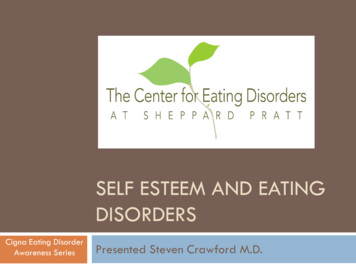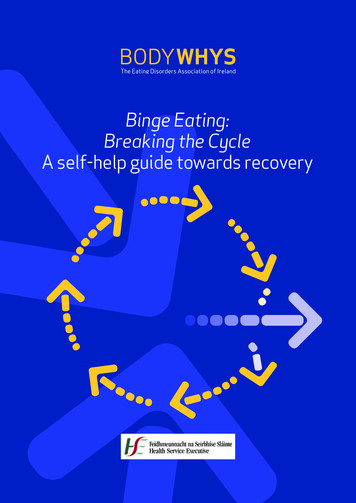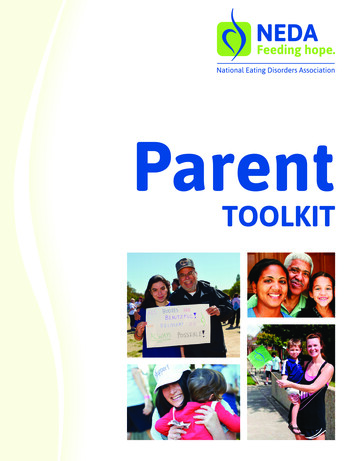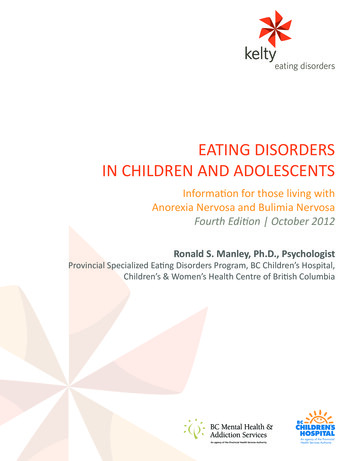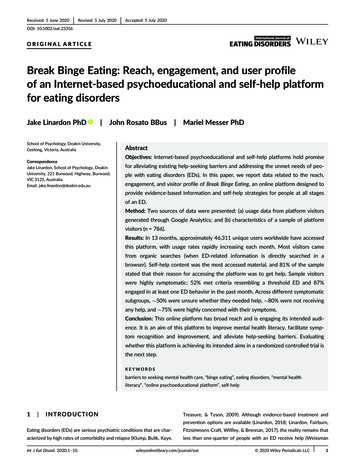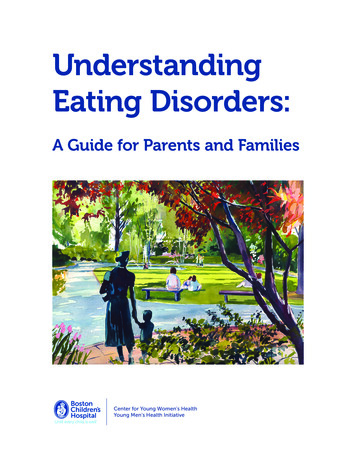
Transcription
UnderstandingEating Disorders:A Guide for Parents and FamiliesCenter for Young Women’s HealthYoung Men’s Health Initiative
IN APPRECIATIONWe would like to recognize our dedicated team of original authors: Blair Ballard,Kendrin Sonneville ScD, RD, LDN, Abigail Hammond MS, RD, LDN, Phaedra ThomasRN, BSN, Amanda Kohn, BFA, Sarah Pitts, MD, and Melissa Freizinger, PhD. Additionalrevisions made by Katrina Schroeder Smith, RD, LDN, Amanda Waldron, RD and AnnaMiller.Special thanks to Jean Emans, MD and Sara Forman, MD for their valuablefeedback and for their commitment to educating young people and their familiesabout eating disorders.This book is dedicated to our patients and all the other adolescents and young adultswho are struggling with eating disorders.The staff of the Center for Young Women’s Health gratefully acknowledges the BostonChildren’s Hospital League for funding this project and our patients and families whohave taught us so much.Last updated May 2019
UnderstandingEating Disorders:A Guide for Parents and FamiliesEating disorders affect millions of young people and adults around the world ofall races and ethnic backgrounds. There are different types of eating disordersincluding: anorexia nervosa (AN) bulimia nervosa (BN), binge eating disorders (BED),avoidant restrictive feeding intake disorder (ARFID), and other specified feedingand eating disorders” (OSFED). Although some of the symptoms of the differentcategories of eating disorders overlap, a person can only have one eating disorderdiagnosis at a time. Eating disorders are found everywhere, particularly in culturesthat focus on weight and body image. It’s not uncommon for negative body imageand unhealthy eating behaviors to go together. But eating disorders are about morethan weight—stress, trauma, loss of control, and participation in certain sports canall contribute to eating disorders. The dedicated team of authors wrote this bookletfor parents because eating disorders have serious health consequences that canbe helped or prevented with early treatment. Fortunately, recovery is likely with thehelp from specially trained health care providers and a supportive family. We hopethis information will help you as a parent to understand what eating disorders are,the different kinds of treatment, the recovery process, and how to help your child.This booklet also includes advice for parents written by a young woman who hasrecovered from an eating disorder, and reflections written by her mom.
TABLE OF CONTENTSWhat are Eating Disorders?1Causes of Eating Disorders3Warning Signs and Symptoms of Eating Disorders5Health Consequences of Eating Disorders7Helping Your Child Prepare for an Eating Disorder Evaluation9The Treatment Team13Treatment Options for Eating Disorders15Therapy for Eating Disorders19What is Healthy Eating?23Healthy Exercise27Yoga31Body Image and Self–Esteem35Do’s and Don’ts for Parents37What I Wish My Parents Knew41My Daughter’s Journey45Glossary of Terms47Resources51
What are Eating Disorders?Eating disorders are complex medical and psychiatric illnesses that affect a person’sphysical and mental health, involving intense emotions and disordered behaviorsrelated to food. These are serious illnesses and can be fatal if left untreated.There are several types of eating disorders and it’s easy to get them confused becausesymptoms may overlap. The different types include anorexia nervosa, avoidant/restrictive food intake disorder (ARFID), bulimia nervosa, binge eating disorder, andother specified feeding and eating disorders (OSFED).Anorexia Nervosa (pronounced: an–or–rex–e–ah nerve–o–sah) involves significantweight loss, lack of appropriate weight gain or refusal to gain weight, and a distortedbody image. People with anorexia drastically limit their food intake (known as foodrestriction, which also involves cutting out certain foods/food groups) and havean intense fear of gaining weight, even though they may be underweight or havelost a significant amount of weight. Anorexia nervosa often presents during earlyadolescence (11–13 years of age) or during the later high school years (17–18 years ofage), when a teen is preparing to go to college, but can occur in people of any age.Someone with anorexia may or may not binge and/or purge.Avoidant/Restrictive Food Intake Disorder (ARFID) is a feeding and eating disordercharacterized by limiting intake of food or food groups without a fear of weight gain.This eating style can lead to consequences such as weight loss, inadequate growth,or a significant nutritional deficiency. ARFID often presents during early adolescence,with the average age of onset being 12-13 years old. Unlike people with other eatingdisorders such as anorexia nervosa, individuals with ARFID do not have significantbody image concerns.Bulimia Nervosa (pronounced: bull–e–me–ah nerve–o–sah) (pronounced: bull–e–me–ah nerve–o–sah) involves cycles of binge eating followed by a purging behavior.People with bulimia will eat an unusually large amount of food in a short period oftime and then purge by vomiting, using laxatives, enemas, or diuretics, or by exercisingexcessively as a way to counteract the binge and avoid gaining weight.1
Binge eating disorder involves eating an unusually large amount of food in a shortperiod of time. People with binge eating disorder feel out of control during theseeating episodes and often feel intense shame or guilt afterwards. People with bingeeating disorder do not purge after bingeing.Other specified feeding and eating disorders (OSFED) involve some combination ofsymptoms of the other eating disorders such as an intense fear of weight gain andpreoccupation with food (thinking about food or having food related thoughts most ofthe day) but do not meet full criteria for another eating disorder. Many individuals withOSFED have a variety of eating disorder symptoms.Disordered eating is a term used to describe the condition when someone doesn’thave all the symptoms of a specific type of eating disorder, but their eating patternsand behaviors put them at risk for developing an eating disorder. For example, extremedieting or orthorexia (an obsession with healthy eating) can lead to an eating disorder.Prevalence rates or how often eating disorders occur varies with each disorder andare difficult to pinpoint as many people suffering may never seek treatment and/orbe diagnosed. Binge eating disorder and OSFED are typically more common thananorexia nervosa and bulimia nervosa. Roughly 5.4% of adolescents age 13-18 willsuffer from anorexia, bulimia, or binge eating disorder at some point, with the rate ofOSFED or disordered eating likely higher.MYTH: Only girls and women have eating disorders.TRUTH: Although girls are more likely to have eating disorders than boys, eatingdisorders do affect males. Males playing sports with weight restrictions suchas gymnastics, swimming, rowing, wrestling and track are at higher risk, butcan occur in anyone. Guys with eating disorders are often focused on gainingmuscle mass, so it might appear that they are simply “getting in shape”.2
Causes of Eating DisordersThere are many theories about what causes eating disorders. There is rarely onecause; most eating disorders are caused by a combination of biological, psychological,and environmental factors. Sometimes the cause may not be completely clear.There are biological reasons that may help to explain why some young people aremore likely to develop an eating disorder. Your child may be more likely to havesymptoms of an eating disorder if he/she has ever been diagnosed with a mooddisorder, anxiety, or depression. Some people with certain traits or temperament and/or family history of eating disorders are at a higher risk of developing anorexia, bulimia,and/or binge eating.There are psychological reasons that may put a young person at risk such asbeing diagnosed with obsessive compulsive disorder (OCD), having past or currenttrauma such as physical, emotional, or sexual abuse, or if a young person feels theneed to have more control over some aspect of their life. Personality traits such asperfectionism, extreme desire to succeed, and impulsivity can also play a role. Familyvalues about body size, appearance, feelings about food, how people feel aboutthemselves and their self–worth are important factors as well.In today’s society, there is an intense focus on thinness and dieting. Websites andsocial media feeds filled with photographs of thin models as well as articles that focuson weight loss abound. Teens might spend hours each day online, constantly lookingat photos and stories, many by “influencers” who do not have an scientific backgroundin nutrition. Even if someone or something is promoting “wellness,” their ideas ormessage may still be influenced by diet culture. Other environmental factors such asparticipating in sports that place emphasis on body shape and size such as dancing,rowing, gymnastics, track, and wrestling may in some cases influence whether ayoung person develops an eating disorder. Finally, stress at school, in sports, with peergroups, or at home, along with cultural attitudes about how a young woman or youngman perceives how they should look and behave may play a role. Keep in mind thatmuch more research is needed to understand risks and possible causes.3
Warning Signs & SymptomsYou can’t tell whether a person is struggling with an eating disorder just by lookingat him or her, but there are often warning signs. Warning signs or “red flags” mightsuggest that a young person may develop or already has an eating disorder. Below isa list of signs that are linked to some or all types of eating disorders. These signs mayalso mean that a person has another kind of health condition, so it’s best to talk withyour child’s primary care provider (PCP) about your concerns before jumping to anyconclusions. Skips meals, makes excuses not to eat, or avoids eating in front of others Over exercises or prioritizes exercise over other previously valued activities Doesn’t eat certain food groups or nutrients (such as carbs or fats) or startsfollowing a vegetarian, vegan, paleo, ketogenic, or other restrictive diet Has unusual behaviors around food such as organizing food, cutting food intosmall pieces, always finding something wrong with food, or pushing food aroundon the plate Obsessively reads nutrition information or counts calories Constantly weighs themselves or “body checks” (looks at their body in the mirroror feels their body with their hands) Chews gum constantly or drinks large amounts of water, coffee, diet soda, orcalorie–free drinks Uses the bathroom after eating or in the middle of meals Consumes unusually large amounts of food at one time Loses control around food Has scars or calluses on hands and knuckles (from using fingers to vomit) Hides food or empty wrappers5
Diets often or eats mostly diet foods Eats secretively (food may be missing from cabinets at home or disappearingquickly)If any of these behaviors are a problem for your child, call your health care provider.MYTH: Everyone with an eating disorder is underweight.TRUTH: Although people with anorexia nervosa are underweight, individualssuffering from bulimia, binge eating disorder, and OSFED (other specifiedfeeding and eating disorder) can be at a normal weight, or even overweight.Also, people with eating disorders may try and hide their bodies by wearingbaggy clothes or dressing differently.6
Health Consequencesof Eating DisordersA “health consequence” is a general term for the many negative physical and mentalhealth changes that can result from disordered eating. Some of the dangers may bespecific to anorexia nervosa (AN), avoidant/restrictive food intake disorder (ARFID),bulimia nervosa (BN), or binge eating disorder (BED), while other health problemscan be associated with more than one type of eating disorder.If food restriction is involved, the body is unable to get the nutrients it needs tofunction properly. In an attempt to conserve energy, the body’s natural responseis to slow down. Typical symptoms such as a significant decrease in the heart rate(pulse) and blood pressure are a direct result of this process, and bone density canbe compromised, which weakens bones and can increase risk for stress fractures andfuture osteoporosis/osteopenia.Purging behaviors upset the body’s normal chemical balance. This causes dangerouschanges to the levels of electrolytes and subsequently can affect major body organsincluding the heart. The major risks associated with binge eating may include highblood pressure, high blood cholesterol, heart disease, and diabetes.The following is an overview of the systems and organs that are affected by eatingdisorder behaviors. Unless specifically noted, these symptoms may affect anyonewith disordered eating. You will note in parenthesis that some of the symptoms andhealth consequences may be more common in AN, ARFID, BN, or BED.7
GENERAL Marked weight changes Weakness/fatigue Dehydration Abnormal electrolytes (AN, BN) Poor concentration, irritabilitySKIN, HAIR, AND TEETH Dry skin (AN, ARFID, BN) Brittle nails (AN, ARFID, BN) Hair loss (AN, ARFID, BN) Fine downy hair growth(lanugo) (AN, ARFID) Cold intolerance (AN, ARFID) Tooth decay (BN)PSYCHOSOCIAL Depression Anxiety Low self–esteem Over valuation withweight/shape Shame or guilt Withdrawal fromfriends/activitiesENDOCRINE Delayed growth, shortstature, delayed puberty, lowhormone levels (AN, ARFID) Delayed onset of menses,loss of periods in females(AN, ARFID, BN) Abnormal thyroid levels(sick euthyroid) Insulin resistance of Type 2diabetes (BED) Loss of libido (AN)GASTROESOPHAGEAL Abdominal pain/bloating Constipation RefluxAN Anorexia NervosaARFID Avoidant/Restrictive Food Intake DisorderBN Bulimia NervosaBED Binge Eating Disorder8CARDIOVASCULAR Low pulse (AN, ARFID, BN) Dizziness (AN, ARFID, BN) Low blood pressure (AN,ARFID, BN) High blood pressure(BN,BED) Arrhythmia/irregularheartbeat (AN, ARFID, BN)MUSCULOSKELETAL Low bone density,osteopenia, osteoporosis(AN, ARFID) Stress fractures (AN,ARFID, BN) Decreased muscle mass(AN, ARFID)
Helping Your Child Preparefor an ED EvaluationYoung people with eating disorder behaviors or symptoms are generally referred toan eating disorder program by their pediatrician, family doctor, nurse practitioner, orphysician assistant. As a parent, it’s normal to feel stressed, anxious and even guilty.It’s important to remember that no one is at fault. An eating disorder is an illness thatrequires treatment and support. For young people with restrictive intake, food is themedicine that will get your child back to a healthy weight. For young people withother types of eating disorders, normalizing food–related behaviors is essential torestoring physical and emotional health. While no two programs are exactly the same,outpatient programs usually do a complete evaluation and provide treatment for thepatient with an eating disorder in addition to support for family members.The approach is often multidisciplinary, which means that more than one health careprovider trained in eating disorders will be involved in your child’s evaluation andtreatment plan. Team members may also involve others in your family and will meetto discuss a plan for offering the guidance and support your child will need at home.College students and young adults often see the team alone, but even they frequentlywork with parents or other family members. Team members in many programsinclude a registered dietitian, mental health and medical professionals. The roles mayvary depending on if the program is family–based, if the treatment team is already inplace, the age of the child, severity of the illness, and other factors.The first visit typically includes the following:1. Medical Evaluation by a health care provider who is specialized in caring forchildren, adolescents and young adults.The doctor or nurse practitioner will: Check your child’s blood pressure, pulse, temperature, height and weightAsk about your child’s medical history and growth, as well as his/her family’smedical history Ask for notes and growth charts to be sent for review9
Ask questions about your child’s eating habits, other behaviors, and physicalsymptoms Perform a physical exam and order tests which may include blood tests,urinalysis (to see if your child is drinking the right amount of fluids), EKG (a testwhich looks at the activity of the heart), or bone density test, as needed 2. Mental Health Evaluation by a licensed therapist experienced in eating disordertreatment. The therapist may have your child fill out a special questionnaire toassess behaviors.Your child and the therapist may talk about: Eating disorder related behaviors Mental health history including depression and anxiety Body image The family’s concerns Thoughts and feelings about being evaluated for an eating disorder Treatment goalsHaving your child work with a therapist is an important part of his/her recovery.The therapist can help your child work on his/her body image, self–esteem, anddiscuss any other emotional issues that may affect their eating habits.3. Nutrition Evaluation by a registered dietitian experienced in working with youngpeople with eating disorders and their parents.The dietitian may talk mostly with your child or only with you (if the treatment isfamily–based) about: Behaviors related to food Health goals and concerns about changing behaviors Food likes and dislikes Common myths about food and eating disorders Creating a healthy eating plan10
In a culture obsessed with dieting and body image, it can be challenging to have ahealthy relationship with food and exercise. A specially trained dietitian can helpyou and your child create a personal plan for healthy eating and exercise anddiscuss harmful myths and confusing messages about food and dieting.After the evaluation:Your child’s health care provider or team will talk to you and your child abouta treatment plan that will likely include: Which level of care is most appropriate for your child right now Individual and family therapy Medical monitoring by your child’s primary care provider (PCP) Nutritional support for you and/or your child with a dietitian Other adjunct therapies such as yoga, mindfulness or relaxation exercisesMYTH: People choose to have an eating disorder.TRUTH: No one chooses to have an eating disorder. Usually a combination ofrisk factors will lead to a person developing an eating disorder. Recovery involvesa lot of time and support from family, friends and eating disorder specialists suchas a therapist, dietitian, and medical provider.11
The Treatment TeamEating disorders are both medical and psychological conditions. Therefore, treatmentusually includes working with a team of specialists including: a medical doctoror nurse practitioner, licensed therapist, a registered dietitian, and sometimes apsychiatrist or family therapist. If your child will be receiving family-based treatment(FBT), the treatment team will include a specially trained FBT therapist.MEDICAL PROVIDERKeeps track of your child’s physical health by checking height, weight, bloodpressure, pulse, and temperature Orders blood or urinalysis, if necessary, to make sure the body’s chemicalsincluding “electrolytes” are balanced Orders special tests such as an EKG to monitor heart rhythm, or a bone densitytest (DXA) to monitor bone health and to see if low bone mass or osteoporosis/osteopenia (thinning of the bones) is present or developing Provides recommendations on weight goals, calcium and vitamin supplements,exercise, hormone replacement, and medication for anxiety or depression Outlines the best treatment options for your child: The The medical provider willsuggest suggest meeting with a therapist and dietitian, starting a family–basedtreatment program, or having your child go to a day program, the hospital orresidential treatment, until medically stable THERAPIST Helps your child improve self–esteem, body image, and confidenceInvolves parents and other family members in providing support, guidance, andsupervision of meals Teaches coping skills to help your child manage emotions and stressful situations13
Addresses other emotional problems that may be related to the eating disordersuch as depression, anxiety, obsessive–compulsive disorder, or substance abuse Creates a place where your child can (privately) discuss his or her needs, goals,and understanding of the eating disorder Provides a safe place for your child to talk about feelings such as sadness, anxiety,or anger Discusses disordered eating thinking and behaviors Teaches strategies to help your child become mentally and physically healthyFAMILY–BASED THERAPIST Provides guidance and support around re–feeding your child Teaches you how to manage mealtime conflict Empowers you to restore your child’s weightREGISTERED DIETITIAN Helps create a safe and healthy eating plan with your family and child Answers questions about food and nutritionOffers suggestions on healthy eating, weight stabilization, calcium and vitaminsupplements, weight goals, and exercise Discusses harmful myths and confusing messages about food and dietingIt’s very important that you and your child meet with a medical provider, therapist,and a dietitian, each of whom has experience working with young people witheating disorders.
Treatment Options forEating DisordersTreatment for an eating disorder is a very individualized process. There are differenttypes and different levels of treatment depending on how medically–stable a personis, how much emotional support they need, the availability of licensed therapiststrained in different modalities such as family based therapy (FBT), and what you as aparent think is the best approach for your child.What to expect at each level of treatment:OUTPATIENTMost young people are treated in an outpatient setting. Outpatient treatment isuseful for those who are medically stable and are able to maintain their normal dailyactivities. The two most common approaches are multi–disciplinary and family–basedtreatment. The choices may vary depending upon the expertise of professionals inyour community.Multi–disciplinary: This type of treatment involves visits with a medical provider,licensed therapist, and registered dietitian. On an outpatient basis, medical providersusually schedule visits for patients who are in treatment for an eating disorderanywhere from once a week to once a month. They will check weight, bloodpressure, heart rate, and a urine sample to make sure the patient is drinking enoughfluids and not overhydrating to influence their weight. Dietitians help by providinginformation about how much food to eat and what kinds of food will be best foryour child. They can offer anything from general guidelines to a structured mealplan. Therapists will assist with strategies to help young people avoid restrictiveeating, binge eating, and/or purging behaviors.Family–based treatment (FBT): This type of treatment puts parents and/or familymembers in charge of the recovery process. Family members control their child’sfood and offer support at every meal and snack with guidance from a licensed15
the family–based therapist and a medical doctor, but other health professionals mayalso be involved. The focus of the treatment is on weight restoration and behavioralchange. Once weight is restored the therapy will focus on normal adolescentdevelopmental issues.How do you know if family–based treatment is right for your family?FBT works best for adolescents who have been diagnosed with anorexia nervosaand who are living at home and who have been sick less than three years. FBT is anintensive family therapy with three phases over a period of 6–12 months and initiallyinvolves the entire family in weekly hour long sessions. Over time, families mayattend the therapy every other week. The parents are coached in how to help theirchild eat (and/or stop purging and over–exercising) and parents are empowered toassume responsibility for their child’s recovery.FBT is a very different approach from traditional therapy and may not be right foreveryone or it may not be available in your community. The focus of FBT is restoringweight and eliminating disordered eating behaviors, whereas traditional therapyfocuses on understanding why the behaviors develop. In FBT the therapist does notmake decisions for the family but serves as an expert consultant; most decisions areleft to parents. FBT requires a long term commitment from parents and also requiresfamilies to sit with their child during and after every meal.Whatever treatment is chosen, a strong treatment team and supportiveenvironment is necessary so that your child will be able to restore weight,maintain their goal weight, and return to their life and age–appropriate activities.INTENSIVE OUTPATIENT PROGRAM (IOP)This type of treatment is for youth either transitioning back into school or workfrom residential treatment, or for youth who are not ready for or do not require ahigher level of treatment. Intensive outpatient treatment usually involves after schoolgroup meetings 3–5 days per week for about 3 hours and includes one supervisedmeal and snack. Someone at this level may or may not also work with an outpatientteam.16
PARTIAL HOSPITALIZATION (OR DAY PROGRAM)This type of treatment is provided for 6–8 hours during the day and patients go homeat night. It includes 2–3 supervised meals and snacks, group and individual therapy.Nutrition education is provided along with various other modalities such as yoga andart therapy.IN–PATIENTThis type of treatment is for people with severe eating disorders who are medicallyunstable or people who were unsuccessful with treatment at a lower level of care.Patients receive 24–hour hospital care and have a very structured schedule ofmeals, therapy, and groups. Once medically stable, patients often go to an intensiveoutpatient program, a residential treatment center, or home with close follow–up.RESIDENTIALThis type of treatment is for medically stable patients who need a 24 hour therapeuticenvironment. Patients live and sleep in a center with others who are struggling witheating disorders. Patients in residential programs have frequent meetings with theirteam (therapist, dietitian, nurse and/or doctor, and psychiatrist) and various kinds ofgroup meetings. After residential treatment, patients often meet with an outpatientteam, or transfer to an intensive outpatient or day program.Treatment of eating disorders varies from person to person. Some people onlyreceive outpatient treatment, while others may need to transition through some orall levels of care as part of their treatment.TRANSITIONINGIt’s very important to support your child when he/she is transitioning from inpatient orresidential to outpatient treatment as this process can be very challenging. Here aresome tips to help you make this transition easier for your child: Before your child leaves inpatient or residential treatment, it’s important to set up anoutpatient team for regular visits. Ask the treatment team to help you find providerswho are experts in eating disorders and who accept your family’s health insurance.Usually an outpatient team consists of a therapist, dietitian, a doctor or nursepractitioner, and often a psychiatrist and a family therapist.17
Some days will be easier than others. It’s okay and normal for you to have somechallenging days with your child. You may be asked to be in charge of your child’s meal plan. Don’t be afraid toseek support from the team, as well as family and friends when necessary, especiallyaround meals. It’s easy to feel overwhelmed if you are supervising the meal plan.Think about one meal at a time, and try not to become discouraged if your child hasa hard time once in a while. Encourage your child to be completely honest with their treatment team and totell them if and when he/she has any thoughts about disordered eating or is usingunhealthy behaviors.Group Support Meetings: This type of meeting is usually held once a week andcan be helpful during treatment. There are also group support meetings for parentsand/or guardians who are taking care of children or young adults with eatingdisorders. At group meetings, parents can provide encouragement and can sharestories, feelings, accomplishments, and coping methods. Group meetings can usuallybe found at local health centers, community agencies, or schools. Ask your child’steam about support meetings in your area.MYTH: People with anorexia don’t eat anything.TRUTH: Most people with anorexia eat, they just restrict the types andamounts of foods they allow themselves to eat. For example, they may onlyeat foods that are low in fat or in calories or only eat small portions of food.18
Therapy for Eating DisordersBecause an eating disorder is both a medical and psychological condition, mostpeople meet with a licensed therapist as part of treatment. Although some familiesworry about stigma attached to seeing a therapist, it is helpful for parents toencourage their child to keep an open mind because most young people find therapyvery helpful.What are the advantages of having your child see a therapist?There are a lot of advantages to seeing a therapist and for each person these benefitscan be different.A therapist can: Provide a safe place for your child to (privately) share feelings without fear of beingjudged for causing problems or hurting someone else’s feelings Give your child a place to address other emotional problems that may be relatedto the eating disorder such as depression, obsessive–compulsive disorder, anxiety orsubstance abuse Help your child process events in his/her life that may affect mood and can lead todisordered eating or destructive behaviors Help your child figure out what caused the eating
Binge eating disorder involves eating an unusually large amount of food in a short period of time. People with binge eating disorder feel out of control during these eating episodes a
